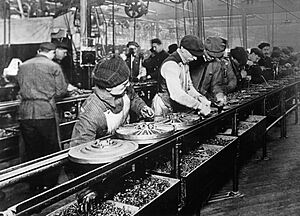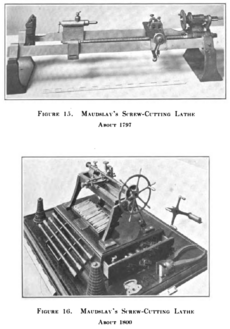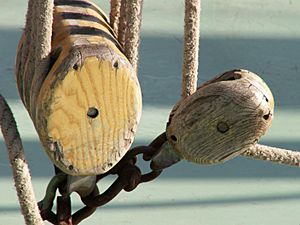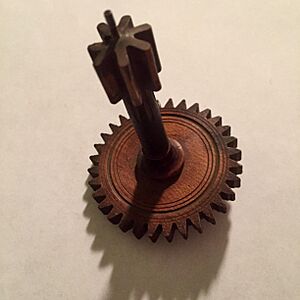Interchangeable parts facts for kids

Imagine you have a toy car, and one wheel breaks. If you can easily take a new wheel from a spare parts kit and put it on, without needing to change anything, then those wheels are interchangeable parts. These are pieces that are made so precisely that they are almost exactly alike. This means one part can replace another without any special adjustments.
Interchangeable parts make it much easier to build new things and fix old ones. You don't need special skills or a lot of time to replace a broken piece. This idea was super important for creating the assembly line in the early 1900s. It's still a key part of how many things are made today.
Early Ideas: A Look Back in Time
Ancient Beginnings: Carthage's Ships
Did you know that the idea of interchangeable parts is actually very old? Over 2,000 years ago, during the First Punic War, the ancient city of Carthage used this concept. Their ships were built with standardized parts. These parts were so similar that they could be swapped out easily. Some even had markings like "put tab A into slot B" to help with assembly!
Modern Interchangeable Parts Begin
Before the 1700s, most complex items, like guns, were made one by one. A skilled craftsman, like a gunsmith, would build each item uniquely. If a part broke, you had to send the whole item back to the craftsman for a custom repair. It was a slow and expensive process.
French Innovations in Weapons
In the late 1700s, a French General named Jean-Baptiste Vaquette de Gribeauval had a big idea. He wanted to standardize weapons, especially artillery (cannons). This meant making all parts the same size and shape. His system, called the Système Gribeauval, made cannons more accurate and easier to repair.
A French inventor named Honoré Blanc took this idea further. He started making muskets (a type of rifle) with interchangeable parts. In 1778, he showed scientists that he could take apart several muskets, mix all their pieces, and then put them back together perfectly. This was a huge step!
America's Interest: Jefferson and Whitney
The American Ambassador to France, Thomas Jefferson, saw Blanc's demonstration in 1785. He was very impressed and wanted to bring this idea to America. Jefferson told the American government about it.
Later, President George Washington also supported the concept. In 1798, a famous American inventor named Eli Whitney signed a contract. He agreed to produce 12,000 muskets using this new system of interchangeable parts. This was a big challenge for manufacturing in the United States.
Around the same time, in London, a gunsmith named Henry Nock also worked on interchangeable parts. Between 1793 and 1795, he made thousands of gun locks for the British military. He used steam-powered machines to make these parts very similar. This helped show that interchangeable parts could be made on a large scale.
Making It Happen: From Idea to Reality
It took many years and a lot of effort to make interchangeable parts a common practice. Developing the right machines and methods was expensive. However, by the mid-1800s, it became clear that using interchangeable parts actually saved money in the long run.
Eli Whitney's Early Efforts
Eli Whitney was excited about making interchangeable parts for the U.S. military's firearms. In 1801, he showed the U.S. Congress ten guns. He took them apart, mixed all the pieces, and then quickly put them back together. Congress was amazed! They wanted all U.S. equipment to use this standard.
This meant that if a gun part broke, a new one could be ordered and easily fitted. The gun wouldn't have to be thrown away. However, Whitney's early guns were still costly and made by hand. Historians now believe that Whitney himself didn't fully achieve true interchangeable parts manufacturing during his lifetime. His family's company, though, did achieve it after his death.
Building Ships Faster: Brunel's Blocks
The first true mass production using interchangeable parts happened in England in 1803. Marc Isambard Brunel, with help from Henry Maudslay, created special machines. They were built at the Portsmouth Block Mills to make pulley blocks for the Royal Navy.
At this time, England was fighting the Napoleonic War. The Navy needed 100,000 pulley blocks every year! Brunel's new machines were revolutionary. They were mostly made of metal, which made them very accurate. These machines could do the work of 110 men with just 10 workers. By 1808, they were making 130,000 blocks annually. Some of these machines were even used until the mid-1900s!

Clocks for Everyone: Eli Terry's Success
In America, Eli Terry was also a pioneer. He used interchangeable parts to make clocks as early as 1800. A study of his clocks from 1800-1807 showed that all their parts could be swapped.
Terry's big breakthrough came in 1806. He signed a contract to make 4,000 clocks in three years. Before this, a clockmaker might only make about a dozen clocks a year! Terry used a milling machine to mass-produce wooden clock wheels and plates. He also used special tools called jigs and templates to make sure all parts were uniform. This allowed him to use an assembly line to build clocks, making them affordable for many households.
Metal Parts Made Easy: North and Hall
A crucial step for metal parts was taken by Simeon North, who lived near Eli Terry. Around 1816, North created one of the first real milling machines for shaping metal. Before this, metal shaping was often done by hand with a file.
Historians agree that by 1832, both Simeon North and John Hall were able to mass-produce complex metal machines, like guns. They used rough metal pieces that were then precisely shaped by milling machines. This made it possible to create many identical metal parts.
Spreading the Idea: Interchangeable Parts Everywhere
From Guns to Cars: A Manufacturing Revolution
Skilled engineers and machinists, many with experience making weapons, helped spread the idea of interchangeable parts. This manufacturing technique moved into other American industries. Clockmakers and sewing machine companies like Wilcox and Gibbs started using it before 1860.
Later, companies making reapers (farm machines) and even large steam engines adopted the system. By the 1880s, bicycle manufacturers also began using interchangeable parts. This meant that true interchangeability, once a difficult achievement, became a common practice across many industries.
This revolution in manufacturing changed how products were made. It allowed for faster production, easier repairs, and lower costs. This made many items, from clocks to cars, available to more people than ever before.
See also
 In Spanish: Piezas intercambiables para niños
In Spanish: Piezas intercambiables para niños
- Allowance (engineering)
- Configuration management
- Engineering fit
- Engineering tolerance
- Fungibility
- Just-in-time (business)
- Louis de Tousard
- Modular design
- Preferred numbers



